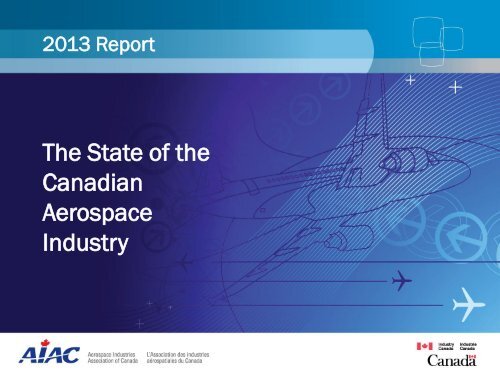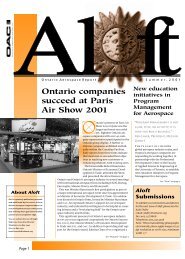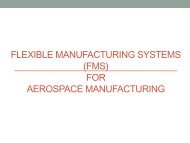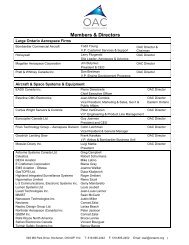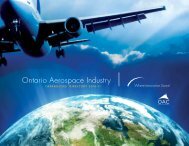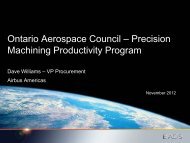The State of the Canadian Aerospace Industry 2013 Report
The State of the Canadian Aerospace Industry 2013 Report
The State of the Canadian Aerospace Industry 2013 Report
- No tags were found...
Create successful ePaper yourself
Turn your PDF publications into a flip-book with our unique Google optimized e-Paper software.
<strong>2013</strong> <strong>Report</strong><strong>The</strong> <strong>State</strong> <strong>of</strong> <strong>the</strong><strong>Canadian</strong><strong>Aerospace</strong><strong>Industry</strong>
Presentation Overview<strong>2013</strong> <strong>Report</strong>• Context and Methodology• Business Drivers & Economic Impact• Innovation & Investment• Trade• Skills• Key Findings• Annex – Sector Definitions2
Context<strong>2013</strong> <strong>Report</strong><strong>The</strong> recent <strong>Report</strong> <strong>of</strong> <strong>the</strong> <strong>Aerospace</strong> Review highlights <strong>the</strong> importance <strong>of</strong>relying on quality information and enhancing collaboration for <strong>the</strong> future <strong>of</strong><strong>the</strong> <strong>Canadian</strong> aerospace industry<strong>Industry</strong> Canada and <strong>the</strong> <strong>Aerospace</strong> Industries Association <strong>of</strong> Canada(AIAC) agreed to leverage <strong>the</strong>ir respective expertise and formed acollaborative research partnership to provide <strong>the</strong> most accurate, detailed andrelevant analysis to both industry and government decision makers<strong>The</strong> two parties agreed that:– <strong>Industry</strong> Canada would develop detailed economic statistics;– AIAC would consult and validate with its network on business drivers,issues and trends; and– <strong>The</strong> statistics, issues and trends would be jointly released on anannual basis3
Key pressing challenges* and opportunities that <strong>Canadian</strong> aerospacefirms** are expected to face in <strong>the</strong> next three years…<strong>2013</strong> <strong>Report</strong> Global economic conditions Introducing new or improved products or services to market Developing new markets Increasing participation into Tier 1 / OEMs supply chains in Canada andabroad Increasing competition from emerging markets Responding to customer requirements to reduce production costsSource: AIAC Annual Business Trends and Drivers Consultation, <strong>2013</strong>*Key pressing challenges are not listed by level <strong>of</strong> importance** <strong>Industry</strong> stakeholders representing close to 70% <strong>of</strong> total <strong>Canadian</strong> aerospace industry employment and revenues5
B$ GDPK FTE<strong>The</strong> <strong>Canadian</strong> aerospace industry* contributed more than $27B GDPand 170,000 FTEs to <strong>the</strong> <strong>Canadian</strong> economy** in 2012<strong>2013</strong> <strong>Report</strong>3025201510517.13.84.68.7<strong>Canadian</strong> <strong>Aerospace</strong> <strong>Industry</strong> GDPEconomic Impact (2012 - GDP)10.1 27.233.83.36.88.4122001601208040<strong>Canadian</strong> <strong>Aerospace</strong> <strong>Industry</strong> EmploymentEconomic Impact (2012 - FTE)10427334568 1721723284356730Manufacturing MRO Total0Manufacturing MRO TotalDirect Indirect InducedDirect Indirect Induced• <strong>The</strong> <strong>Canadian</strong> aerospace industry is responsible for more than $42B <strong>of</strong> revenues from firmsacross multiple industries in Canada ($22.8B <strong>of</strong> direct revenues)• Canada’s aerospace manufacturing sector is ranked 5 th among OECD countries in terms <strong>of</strong>revenues and GDP and 1 st in terms <strong>of</strong> relative importance over total manufacturing (2010)* MRO service sector (excludes MRO activity performed by manufacturers and airlines). Space manufacturing is included in <strong>the</strong> aerospacemanufacturing sector** Direct: Firms where aerospace is <strong>the</strong>ir main activity; Indirect: <strong>Canadian</strong> suppliers to firms where aerospace is <strong>the</strong>ir main activity; Induced: Offseteconomic impact <strong>of</strong> direct and indirectSource: <strong>Industry</strong> Canada. Economic modelling based on data from Statistics Canada (Business Registry and Cansim), Statistics Canada National Input-Output Multipliers (2008 adjusted to 2011 GDP and employment), Canada Revenue Agency, OECD and firm level observations, <strong>2013</strong>6
<strong>The</strong> <strong>Canadian</strong> aerospace industry is active across <strong>the</strong> country…<strong>2013</strong> <strong>Report</strong><strong>Canadian</strong> <strong>Aerospace</strong> Manufacturing SectorRegional Direct GDP Analysis (2011)<strong>Canadian</strong> <strong>Aerospace</strong> MRO SectorRegional Direct GDP Analysis (2011)Western Canada8%AtlanticProvinces5%AtlanticProvinces11%Quebec21%Ontario27%Quebec60%Western Canada46%Ontario22%• Atlantic Canada was <strong>the</strong> fastest growing region in both segments (close to 20%) during <strong>the</strong>2006-2011 period• Central Canada accounts for <strong>the</strong> vast majority <strong>of</strong> <strong>the</strong> manufacturing sector• Western Canada plays a dominant role in terms <strong>of</strong> MRO services**MRO service sector (excludes MRO activity performed by manufacturers and airlines)Source: <strong>Industry</strong> Canada. Economic modelling based on data from Statistics Canada (Business Registry and Cansim), Canada Revenue Agency and firmlevel observations, <strong>2013</strong>7
<strong>The</strong> <strong>Canadian</strong> aerospace industry is comprised <strong>of</strong> over 700 firms*<strong>of</strong> all sizes<strong>2013</strong> <strong>Report</strong>Small(1-99 FTEs)85%<strong>Canadian</strong> <strong>Aerospace</strong> <strong>Industry</strong> Size <strong>of</strong> FirmShare Analysis (2012)Medium(100-499 FTEs)11%Large(500+ FTEs)4%During <strong>the</strong> last 10 years (2002-2012):• <strong>The</strong> <strong>Canadian</strong> aerospace manufacturingsector has experienced:• A sizeable increase in number<strong>of</strong> medium-sized firms (100-499 FTEs);• A slight decline in number <strong>of</strong>small-sized firms (1-99 FTEs);and• A few firms transitioningbetween size categories.• A number <strong>of</strong> MRO** medium-sized firmsevolved to large firms (500+ FTEs)*Firms where aerospace is <strong>the</strong>ir primary business activity**MRO service sector (excludes MRO activity performed by manufacturers and airlines)Source: <strong>Industry</strong> Canada. Economic modelling based on data from Statistics Canada (Business Registry and Cansim), Canada Revenue Agencyand firm level observations, <strong>2013</strong>8
<strong>The</strong> <strong>Canadian</strong> aerospace manufacturing sector is one <strong>of</strong> <strong>the</strong> most R&Dintensive* in <strong>the</strong> <strong>Canadian</strong> economy…<strong>2013</strong> <strong>Report</strong><strong>Canadian</strong> <strong>Aerospace</strong> Manufacturing SectorR&D Intensity Analysis (2012)<strong>Aerospace</strong>Manufacturing20%Total Manufacturing4%Total Industries1%0% 5% 10% 15% 20% 25%R&D intensity on GDP• <strong>Canadian</strong> aerospace manufacturers increased <strong>the</strong>ir R&D investment by more than 40% in<strong>the</strong> last five years (2007-2012)• <strong>The</strong> vast majority <strong>of</strong> <strong>the</strong> R&D is performed in Central Canada (65% in Québec and 29% inOntario in 2010)• On a global basis, <strong>the</strong> <strong>Canadian</strong> aerospace manufacturing sector is in <strong>the</strong> middle <strong>of</strong> <strong>the</strong>pack <strong>of</strong> G7 countries in terms <strong>of</strong> R&D intensity (2010)*R&D intensity: R&D investment / GDPSource: <strong>Industry</strong> Canada. Economic modelling based on data from Statistics Canada (Business Registry and Cansim), Canada RevenueAgency, OECD and firm level observations, <strong>2013</strong>9
…and large-sized manufacturing firms are <strong>the</strong> biggest investors in R&D<strong>2013</strong> <strong>Report</strong><strong>Canadian</strong> <strong>Aerospace</strong> Manufacturing SectorSize <strong>of</strong> Firm Footprint Analysis (2012)R&D8%92%Number <strong>of</strong> firms93%7%0% 20% 40% 60% 80% 100%Share <strong>of</strong> activity SME (1-499 FTEs) Large (500 + FTEs)• SMEs (1-499 FTEs) represent 93% <strong>of</strong> <strong>Canadian</strong> aerospace manufacturingfirms* while large firms (500+ FTEs) play a significant role in terms <strong>of</strong> R&Dinvestment* Firms where aerospace is <strong>the</strong>ir primary business activitySource: <strong>Industry</strong> Canada. Economic modelling based on data from Statistics Canada (Business Registry and Cansim), Canada Revenue Agency andfirm level observations, <strong>2013</strong>10
<strong>The</strong> <strong>Canadian</strong> aerospace manufacturing sector is a leaderin terms <strong>of</strong> productivity growth*…<strong>2013</strong> <strong>Report</strong><strong>Aerospace</strong> Manufacturing Sector 5 YearProductivity Comparative Analysis<strong>Aerospace</strong> Manufacturing19%Total Manufacturing8%Total Industries1%0% 2% 4% 6% 8% 10% 12% 14% 16% 18% 20%Value Added Per Employee Grow th (2007-2012)• Value added (GDP) per employee in <strong>the</strong> aerospace manufacturing sector is more than60% higher than total manufacturing and 80% higher than total economy• <strong>The</strong> <strong>Canadian</strong> aerospace manufacturing sector ranked #1 among OECD countries in terms<strong>of</strong> productivity growth* (2004-2009 period)*Productivity growth estimates based on value added per employee growth trends analysis (GDP/FTE)Source: <strong>Industry</strong> Canada. Economic modelling based on data from Statistics Canada (Business Registry and Cansim), OECD and firm levelobservations, <strong>2013</strong>11
Collaboration is at <strong>the</strong> forefront <strong>of</strong> innovation in <strong>the</strong> <strong>Canadian</strong> aerospacemanufacturing sector…<strong>2013</strong> <strong>Report</strong>Planned participation in innovation* collaboration activitiesby <strong>Canadian</strong> aerospace firms** over <strong>the</strong> next three yearsUniversitiesGovernmentResearchInstitutesSuppliersCustomers(e.g. Tier 1 andOEMs)Basic Research(TRL*** 1-3)Applied Research(TRL 4-6)TechnologyDemonstration(TRL 4-6)Product Development(TRL 7-9)Legend High Medium LowPlanned level <strong>of</strong>participationSource: AIAC Annual Business Trends and Drivers Consultation, <strong>2013</strong>* Only applicable to <strong>Canadian</strong> aerospace operations that plan to perform R&D activities in Canada in <strong>the</strong> next three years** <strong>Industry</strong> stakeholders representing close to 70% <strong>of</strong> total <strong>Canadian</strong> aerospace industry employment and revenues*** Technology Readiness Level (TRL) is a measure used to assess <strong>the</strong> maturity <strong>of</strong> evolving technologies during its development.12
Most important R&D* investment considerations** for<strong>Canadian</strong> aerospace firms***…<strong>2013</strong> <strong>Report</strong> Availability <strong>of</strong> skilled labour Direct and indirect (e.g. tax credit) Government support programs Ability to connect with high quality post-secondary institutions Access to research infrastructure Geopolitical stabilitySource: AIAC Annual Business Trends and Drivers Consultation, <strong>2013</strong>* Only applicable to <strong>Canadian</strong> aerospace operations that plan to perform R&D activities in Canada in <strong>the</strong> next three years** * Investment drivers are not listed by level <strong>of</strong> importance*** <strong>Industry</strong> stakeholders representing close to 70% <strong>of</strong> total <strong>Canadian</strong> aerospace industry employment and revenues13
<strong>The</strong> <strong>Canadian</strong> aerospace manufacturing sector is one <strong>of</strong> <strong>the</strong> most export intensivewith nearly 80% <strong>of</strong> its products exported to highly diversified markets…<strong>2013</strong> <strong>Report</strong><strong>Canadian</strong> <strong>Aerospace</strong> Product ExportsRegional Distribution Analysis (2012)Rest <strong>of</strong> World2%Africa3%Central & SouthAmerica3%Middle East3%Asia11%USA54%Europe24%• More than 45% <strong>of</strong> <strong>Canadian</strong> aerospace product exports are destined to non US markets incontrast to close to 20% for total <strong>Canadian</strong> goods exports• Europe: Close to 25% <strong>of</strong> aerospace product exports in contrast to less than 10% for total<strong>Canadian</strong> goods exports• While <strong>Canadian</strong> aerospace product exports to Asia grew by 158% and to Europe grew by 15%,aerospace exports <strong>the</strong> US declined by 17% for <strong>the</strong> 2007-2012 periodSource: <strong>Industry</strong> Canada. Economic modelling based on data from Statistics Canada (Business Registry and Cansim), Trade Data Online and firm levelobservations, <strong>2013</strong>14
Close to 60% <strong>of</strong> Canada’s aerospace product* exportsare intermediate inputs supporting global supply chain activities….<strong>2013</strong> <strong>Report</strong><strong>Canadian</strong> <strong>Aerospace</strong> Product ExportsSegment Analysis (2012)Flight Simulator4%Landing Gear6%Aircraft39%Avionics11%O<strong>the</strong>r Parts12%Aeroengines andrelated parts28%• Landing gear and flight simulator segments had <strong>the</strong> highest growth rates for <strong>the</strong> 2007-2012 period• Although aircraft is <strong>the</strong> most dominant segment, engines and related parts play a keyrole in terms <strong>of</strong> Canada’s aerospace exports footprint*Space products included in different market segments, aircraft includes airplane and rotorcraftSource: Trade Data Online based on Statistics Canada and Canada Revenue Agency information, <strong>2013</strong> 15
<strong>The</strong> <strong>Canadian</strong> aerospace industry is a highly diverse and skilled talent pool*…<strong>2013</strong> <strong>Report</strong><strong>Canadian</strong> <strong>Aerospace</strong> Manufacturing SectorEmployment Category Analysis (2012)<strong>Canadian</strong> <strong>Aerospace</strong> MRO SectorEmployment Category Analysis (2012)O<strong>the</strong>r occupations 9%O<strong>the</strong>r occupations 2%Corporate 20%Corporate 24%Logistics and distribution5%Logistics anddistribution 15%Production 42%Scientific, R&D,engineering and relatedtechnicians 31%Production 28%Scientific, R&D,engineering and relatedtechnicians 24%• More than two thirds <strong>of</strong> <strong>the</strong> total aerospace industry workforce is qualified as skilled labour**• Average salary for aerospace manufacturing is close to 40% higher than total industries (20%higher for MRO***)• Engineers account for close to 50% <strong>of</strong> <strong>the</strong> scientific, R&D, engineering and related technicianscategory in <strong>the</strong> manufacturing sector (+42% for <strong>the</strong> 2002-2012 period)* Corporate: Includes activities such as senior management, market research/marketing, operation management, supply chain management and customerrelationship management** As defined by <strong>the</strong> National Occupational Classification (NOC)*** MRO service sector (excludes MRO activity performed by manufacturers and airlines)Source: <strong>Industry</strong> Canada. Economic modelling based on data from Statistics Canada (Business Registry and Cansim), Canada Revenue agency and firm levelobservation, <strong>2013</strong>16
…which will require targeted occupations and investments in talent management<strong>2013</strong> <strong>Report</strong>•Key employment category needs in <strong>the</strong> next five years: Engineers, scientists and R&D specialists; Advanced manufacturing technicians; MRO highly skilled personnel; and Supply chain management field experts•Retirement rate will play a key factor in <strong>the</strong> next ten years•Size <strong>of</strong> workforce in Canada is expected to grow•High interest in increasing investment in skills development and upskillingover <strong>the</strong> next five yearsSource: AIAC Annual Business Trends and Drivers Consultation, <strong>2013</strong>* <strong>Industry</strong> stakeholders representing close to 70% <strong>of</strong> total <strong>Canadian</strong> aerospace industry employment and revenues 17
Key findings…<strong>2013</strong> <strong>Report</strong>•<strong>The</strong> <strong>Canadian</strong> aerospace industry is a strategic contributor to <strong>the</strong> <strong>Canadian</strong> economy interms <strong>of</strong> innovation, employment, GDP and advanced manufacturing and serviceactivities•R&D investment, collaboration, supply chain participation and competition wi<strong>the</strong>merging markets (e.g. productivity) is expected to drive and challenge <strong>the</strong> <strong>Canadian</strong>aerospace industry in <strong>the</strong> coming years•<strong>The</strong> <strong>Canadian</strong> aerospace manufacturing sector is one <strong>of</strong> <strong>the</strong> most R&D intensive in <strong>the</strong><strong>Canadian</strong> economy but is in <strong>the</strong> middle <strong>of</strong> <strong>the</strong> pack in terms <strong>of</strong> G7 competing countries•<strong>The</strong> <strong>Canadian</strong> aerospace manufacturing sector is one <strong>of</strong> <strong>the</strong> most export intensive andexport diversified <strong>of</strong> <strong>the</strong> <strong>Canadian</strong> economy•<strong>The</strong> <strong>Canadian</strong> aerospace industry talent pool needs are evolving and will requiretargeted occupations and investmentsContact: Philippe Richer Jim Quick<strong>Industry</strong> Canada<strong>Aerospace</strong> Industries Association <strong>of</strong> Canada (AIAC)philippe.richer@ic.gc.ca jim.quick@aiac.ca(613) 941-3460 613-232-4297 18
<strong>2013</strong> <strong>Report</strong>Annex–Sector Definitions19
Definitions <strong>of</strong> <strong>the</strong> <strong>Canadian</strong> <strong>Aerospace</strong> Manufacturingand <strong>the</strong> MRO Service Sectors<strong>2013</strong> <strong>Report</strong><strong>Aerospace</strong> Manufacturing SectorMRO Service Sector*Main activities:Main activities:•Aircraft assemblies, subassemblies and parts•Aircraft engines and engine parts•Aircraft fuselage, wing, tail and similarassemblies•Tail and wing assemblies and parts(empennage)•Flight simulator•Developing and producing prototypes foraerospace products• Space vehicle, parts and propulsion units,guided missile and space vehicle engines•Telecommunication satellites and components•Avionics•Helicopters, propellers and parts• Aircraft heavy maintenance, servicing andrepairing• Aircraft engines maintenance, servicing andrepairing• Aircraft components and o<strong>the</strong>r systemsmaintenance, servicing and repairing• Aircraft line maintenance (aircraft servicing atairports – excluding sales <strong>of</strong> fuel revenues)• Aircraft ferrying service• Aircraft inspection service• Aircraft testing services• Aircraft upholstery repair*MRO service sector (exclude MRO activity performed by manufacturers and airlines)20


